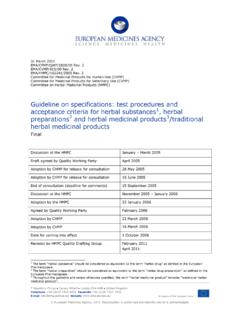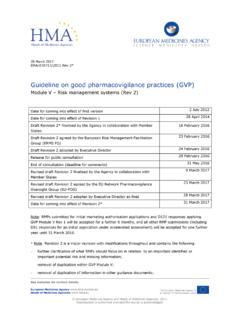Transcription of Stability Testing of Dietary Supplements - NSF International
1 Stability Testing of Dietary Supplements January 2011. Stability Testing Guideline for Dietary Supplements Final Draft January 2011. Provided by the NSF Stability Testing Working Group Table of Contents Introduction Page 2. Scope Page 2. General Principles of Shelf-life Studies Page 3. Selection of Batches Page 4. Bracketing or Matrixing Page 5. Types of Testing Page 6. Container-closure Systems Page 10. Types of Studies / Testing to Support Shelf-life (Expiration) Dating Claims Accelerated Studies Page 10. Long-Term Studies Page 12. Reserve Sample Testing Page 13. Open Product Testing Page 14. Excursion Testing for Finished Product Page 14. Shelf-life Study Protocol Page 15. Shelf-life Evaluation / Study Report Page 16. Statements / Labeling Page 17. Process or Product Changes Page 17. Glossary Page 18. References Page 22. Appendix Page 23. Page 1 of 26. Stability Testing of Dietary Supplements January 2011. Introduction The purpose of this guideline is to present recommendations for supporting the voluntary shelf-life (expiration) dating claims of Dietary Supplements .
2 Federal regulations do not require the use of Dietary supplement product expiration dates. However, the Federal Register GMP Preamble, June 25, 2007, Volume 72 Page, 34856 states, the preamble to the 2003 cGMP Proposal emphasized that, if you use an expiration date on a product, you should have data to support that date (68 FR 12157 at 12204) . For the purpose of this document, these recommendations also apply to Dietary Supplements that voluntarily claim best by , use before , etc. dates in lieu of a specific expiration date.. This document is intended to provide practical guidance on what should be considered when developing voluntary written shelf-life study protocols to establish or confirm expiration dating of Dietary Supplements . It is written so as to leave sufficient flexibility to address the range of situations that may be encountered due to the specific scientific considerations and characteristics of the products and container-closure systems being evaluated.
3 For markets outside of the United States, applicable regulations from other countries should be followed. The initial draft of this guideline was developed based on the ICH. Guidelines developed for conducting Stability Testing for Pharmaceutical products. Scope These guidelines are intended to be applicable to Dietary Supplements as defined and covered by DSHEA and the United States Food and Drug Administration's Code of Federal Regulations Title 21, Part 111 [Current Good Manufacturing Practices in Manufacturing, Packaging, Labeling, or Holding Operations for Dietary Supplements ]. Page 2 of 26. Stability Testing of Dietary Supplements January 2011. also known as 21 CFR Part 111, but may also be applied to Dietary ingredients and other components. General Principles of Shelf-life Studies The user of this guideline should: a) understand that the FDA final GMP rule for Dietary Supplements does not require the establishment of product expiration dates, but that any expiration date placed on a product label (including claims such as, ``best if used by'') should be supported by data.
4 B) consider and identify issues related to the organoleptic, physical, chemical, biological and microbiological characteristics of the components under long term storage. c) consider the impact that manufacturing, packaging, labeling, and holding/warehouse processes may have on the Stability profile of products. d) ensure that the finished products have initial release specifications that help assure compliance with long-term Stability specifications and suitable overages. e) determine the Stability of the finished product in the container-closure system that will be marketed. f) consider any historical data related to the formulation or the container-closure system that may be relevant to the Stability of the product. g) review applicable label claims related to Stability aspects of the finished product to ensure that Stability studies are designed to support these claims, as necessary. Page 3 of 26. Stability Testing of Dietary Supplements January 2011.
5 H) understand the distribution (including transportation) and storage conditions that the Dietary supplement will be subjected to over its shelf life and factor these conditions into the Stability study as necessary. i) consider the suitability of accelerated Stability studies on new product forms, as some components may react differently at increased temperatures or humidity levels than at ambient conditions. j) consider the potential for the formation of degradation products and set corresponding Stability indicating specifications as necessary. k) understand that while federal regulations do not require the use of product expiration dates on marketed Dietary Supplements , if an expiration date is used reserve samples must be maintained for one year past the shelf-life date (per 21. CFR Part 111 Sections 83 and 465). Also written records related to the product must be retained for one year past the shelf-life date (per 21 CFR 111 Section 605).
6 Therefore if a shelf life date is added to or extended for a Dietary supplement , the user may need to update the period of time that reserve samples and/or written records are maintained for that Dietary supplement . Selection of Batches Stability data should be gathered on batches that are representative of the product and container-closure system being marketed. Where possible, variables that are applicable to the normal manufacturing and distribution processes ( , different batches of components) should be included. If laboratory or pilot-scale batches are used initially for Testing , the manufacturing process used should closely simulate full-scale production and the product should be packaged in containers of the same quality and meeting the same specification(s) as that intended for marketing. After an expiration date is Page 4 of 26. Stability Testing of Dietary Supplements January 2011. established or confirmed initially, it may be appropriate to place a new batch of product on shelf-life study under long-term conditions annually or more frequently.
7 All batches used in Stability Testing should be fully traceable back to the component and packaging material lots used. To establish an expiration date for a new or modified product or container-closure system: It may be appropriate to establish initial shelf life dating through either long- term or accelerated Stability studies. If accelerated Stability studies are used initially, it is recommended that at least one of the first full-scale batches also be tested under long- term conditions. An initial expiration date may be established from the accelerated study results and modified as long-term study results become available. To establish or confirm an expiration date for an existing product or container- closure system for which no previous Stability data is available: It is recommended that the procedure described above for new products be followed. In addition, Testing of reserve samples of the existing product in the same or similar container-closure system may be used to initially establish or confirm the expiration date, provided that sufficient reserve samples also are maintained for GMP retention sample purposes.
8 Bracketing or Matrixing Shelf-life studies should be conducted on each unique Dietary supplement formulation and container-closure system combination unless bracketing or matrixing can be applied. Studies using bracketing [ Testing only the extremes of certain Dietary supplement / container-closure factors (such as potency or package size)] or matrixing [ Testing only a selected subset of all possible combinations of Dietary supplement /. Page 5 of 26. Stability Testing of Dietary Supplements January 2011. container-closure at any given time] should be scientifically justified. See ICH Guideline Q1D for suggestions on how bracketing and/or matrixing are applied to shelf-life studies of new drug substances or products. p4 NOTE: The criteria included in Q1D may be instructive, but are not required for Dietary supplement shelf-life studies. Types of Testing All shelf-life Testing should be undertaken using defined specifications.
9 These specifications should include the: (a) test parameters to be performed; (b) acceptance criteria / values for each item tested and (c) appropriate and scientifically valid analytical procedure to be used for each test item. Test Parameters The properties tested during shelf-life studies should include any characteristics that are subject to change during storage and that could affect product quality, safety, label claims, or efficacy. The parameters may include organoleptic properties, Dietary ingredient strengths, chemical fingerprints 1, ingredient degradation products, microbial growth, preservative content, moisture content, disintegration, dissolution, pH, viscosity and oxidation, and should be customized for each product. Determination of the appropriate Stability -indicating (or rate limiting) analyte(s) is 1. Regarding chemical fingerprints these are often at least as important, if not more important, than the content of individual chemicals, at least in the case of complex chemical mixtures (such as many herbal and animal ingredients).
10 Please refer to AHPA's document Use of Marker Compounds in Manufacturing and Labeling Botanically Derived Dietary Supplements and various European documents such as EMEA's Guideline on Quality of Herbal Medicinal Products /. Traditional Herbal Medicinal Products (CPMP/QWP/2819/00 Rev. 1).]. Page 6 of 26. Stability Testing of Dietary Supplements January 2011. dependent on a preliminary review of the components to determine which has the shortest shelf-life based on its Stability characteristics. Generally the parameters should include all quantitative label claims for components subject to degradation, where scientifically valid test methods exist for the components. Claimed components which are not subject to degradation, such as many kinds of minerals, often do not need to be tested. In highly complex products/matrices, it may be appropriate to select only the most labile components for shelf-life Testing . The decision is typically based on available historical data.











